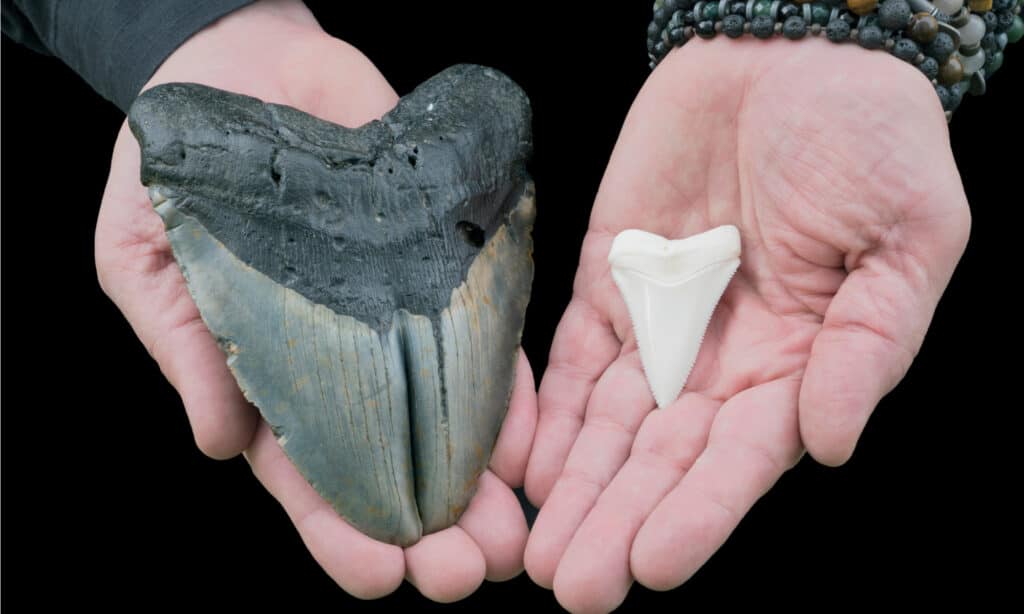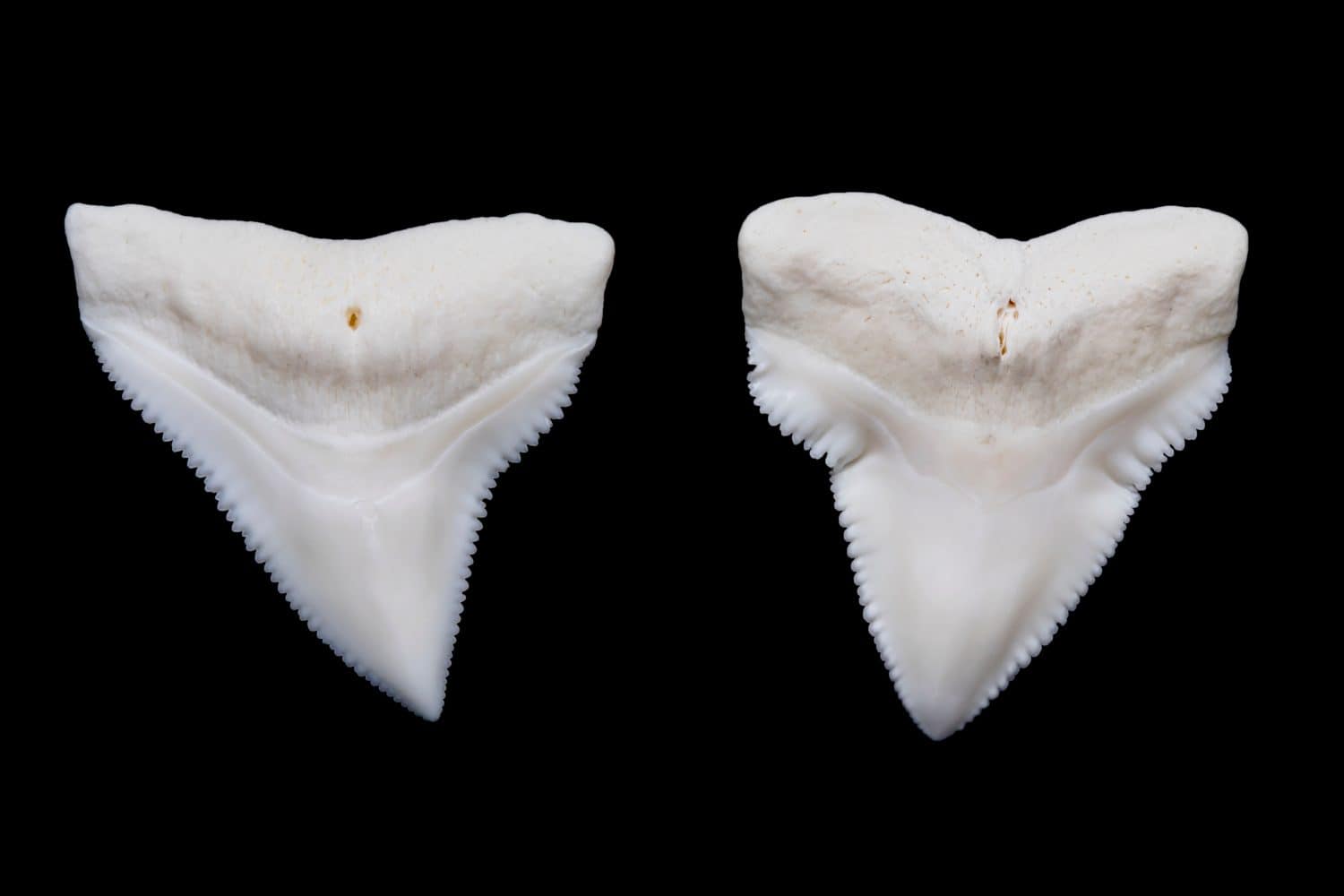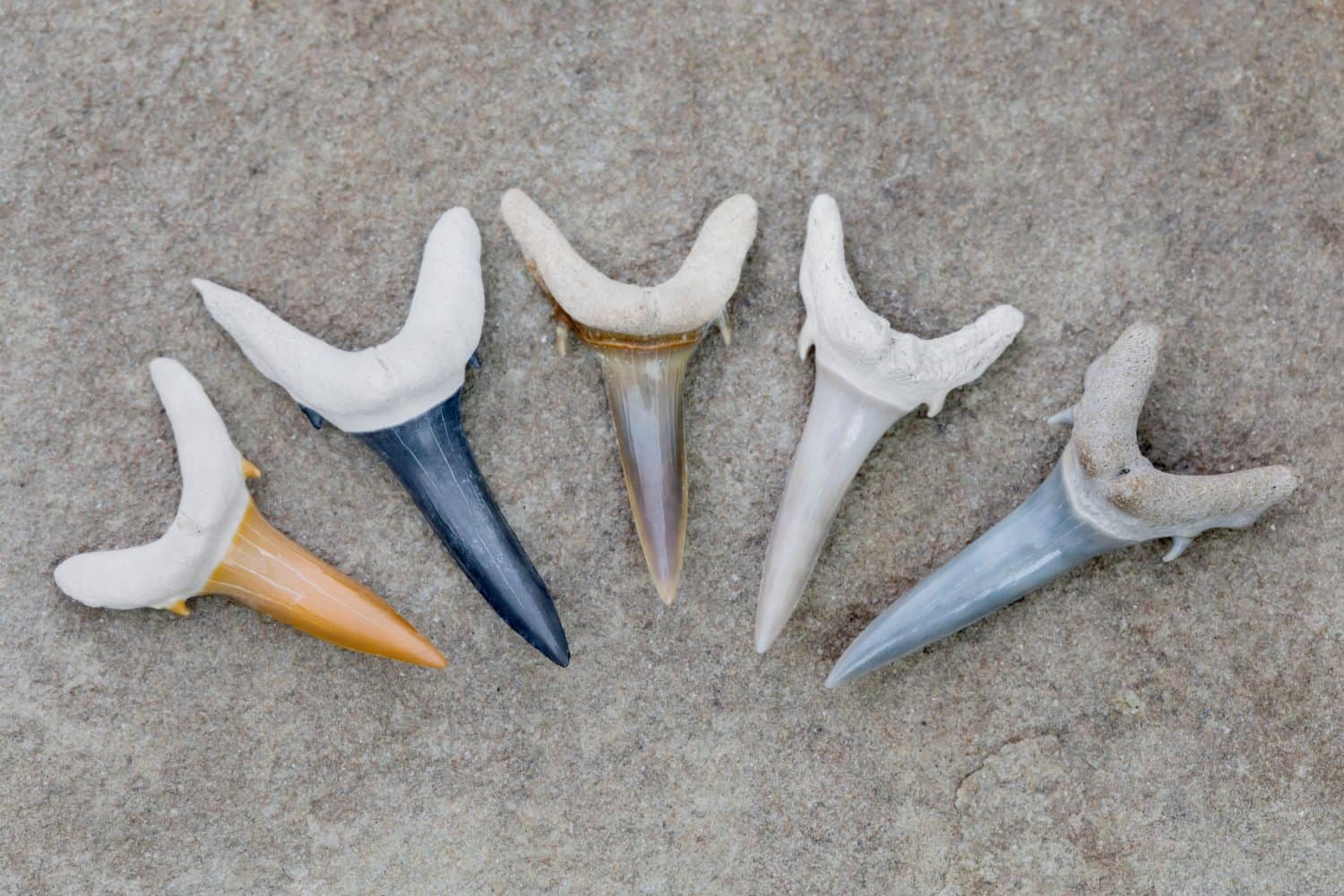Interested in learning more about different types of shark teeth?
If you’ve ever been to the beach, then you may be familiar with collecting sea shells. However, did you know that, nestled among all those colorful and vibrant shells, you can find real shark teeth?
Because of the unique anatomy and function of a shark’s tooth, they can lose around a tooth a week. If an injury occurs that results in the loss of teeth, this number can increase. As a result, millions of shark teeth are lit across the ocean, with many ending up on the shore just like shells. When the teeth first fall from the shark’s mouth, they are white. However, as the tooth ages, it slowly becomes shiny black. Black shark teeth that you find are more similar to fossils than fresh teeth. However, when walking the beach or wading in the shallows, you may find both white and black shark teeth.
Now that you’ve learned more about shark teeth, continue reading below to learn how to identify 7 different types of shark teeth!
1. Megalodon Shark Tooth

Megalodon teeth are the largest of all known shark teeth!
©Nico Ott/Shutterstock.com
The megalodon shark tooth is likely one of the most sought-after shark teeth. These massive teeth belong to the extinct megalodon that lived an estimated 23 to 3.6 million years ago. They are known as one of the largest and strongest predators to have existed on Earth. They had around 276 teeth at a time, with them replacing their teeth often like other species of sharks.
Megalodon tooth fossils can be anywhere from 3 to 5 inches in length. However, some fossils have been found over 7 inches long. Aside from major size differences, megalodon teeth greatly resemble those of the great white. They form a neat, symmetrical triangle shape. However, while both types of teeth share serrations, that of the megalodon is different. Megalodon teeth have fine serrations compared to wider or thicker ones.
The tooth itself is thick, with a notable root. One of the most unique features of a megalodon shark tooth is the bourlette, which many other modern species of shark lack. This is a dark area of exposed dentine near the root of the tooth.
2. Great White Shark Tooth

Great white shark teeth (right) are similar in appearance to the megalodon’s but much smaller.
©Mark_Kostich/Shutterstock.com
As mentioned above, the tooth of a great white shark is quite similar to that of a megalodon in shape and symmetry. However, there are several important distinctions to note.
The most notable difference is size. Whereas the megalodon shark tooth can easily be the size of one’s palm, the great white shark tooth is much smaller. On average, the teeth you find belonging to this shark will only be around 1.5 to 2.5 inches in length. Great white tooth fossils are also much thinner, with a thin root, despite their broad appearance. While this tooth will also be serrated, the serrations are coarse.
These teeth are symmetrical. However, this symmetry isn’t always perfect, with teeth closer to the back of the mouth not displaying the same curbed structure of other species but being noticeably less symmetrical than teeth at the front of the mouth.
3. Tiger Shark Tooth

Tiger
sharks have deeply curved teeth that set them apart from other species.
©Matt9122/Shutterstock.com
The tiger shark has a highly distinctive tooth. Whereas many of the shark teeth you find will present a fairly symmetrical shape, the same cannot be said for this shark’s teeth. Tiger shark teeth are often deeply notched in such a way that they appear curved. They also have coarse serrations. A tiger shark tooth is also short, with the tooth itself appearing as long as the root. Often, the entirety of the tooth is only around 1 inch in length. However, they may be as large as 1.5 to 2 inches long.
Although the shape of the tooth is curved, it is flat. You can roughly identify where in the mouth the tooth was positioned based on its flatness. This is because teeth that were located further toward the back of the mouth are flatter than those located in the front.
Sometimes, modern-day tiger shark teeth can be mistaken for those of a similar but extinct species known as Physogaleus aduncus. However, these sharks sported thicker roots with finer serrations. But, it may be difficult to tell the two apart when a tiger shark tooth is worn or damaged.
4. Lemon Shark Tooth

Although they may look perfectly symmetrical, the lemon shark’s teeth are actually curved!
©Mark_Kostich/Shutterstock.com
Of the sharks mentioned thus far, the lemon shark tooth has a fairly distinctive shape. It is not as symmetrical as the great white shark’s, nor as large as the megalodon’s. And, while the lemon shark’s tooth does sport a notable curve, it is not nearly to the degree of that of the tiger shark.
The teeth of the lemon shark are flat and narrow and have no serrations. These teeth are also quite small, with the average size being around 0.75 inches. At first glance, the lemon shark’s tooth may appear to make a complete 90-degree angle at the corners where the blade meets the root. Often, it isn’t until closer inspection that the curve is noted.
Although the tooth of the lemon shark might stand out from other teeth discussed previously above, it can often resemble other predators’ teeth, including the bull shark.
5. Bull Shark Tooth

Bull shark teeth have what is known as tapering serrations.
©Mark_Kostich/Shutterstock.com
In terms of orientation alone, the bull shark’s tooth and the lemon shark’s tooth can appear identical. This is because both teeth sport notable roots with blades that make seemingly perfect 90-degree angles despite being slightly curved. Both are also flat, although the bull shark’s tooth is broad.
Two of the largest differences between the bull shark’s teeth and the lemon shark’s are serrations and size. Bull sharks have what is known as tapered serrations. Toward the root of the tooth, the serrations are large and coarse. However, the further down the blade you look, the finer the serrations. The entirety of the blade has serrations, although they are almost unnoticeable toward the point due to their small size.
The bull shark also has a slightly larger tooth, larger than that of the lemon shark but much smaller than other species discussed so far. On average, a bull shark tooth measures around 1 inch. However, some individual teeth may be smaller than that.
6. Nurse Shark Tooth

The nurse shark has small teeth designed for crushing.
©frantisekhojdysz/Shutterstock.com
Nurse sharks have a much different diet than their other shark relatives, which results in much different teeth. Whereas predators such as the great white shark or tiger shark need strong teeth for ripping and tearing, the nurse shark needs different, specialized teeth. This is because much of their diet is made up of crustaceans, and, as a result, their teeth are designed for crushing.
The mouth of a nurse shark is filled with small, sharp, serrated teeth. They sport a single row of teeth on both the upper and lower jaw. It is important to note that the serrations on a nurse shark’s tooth are not like those seen thus far. Instead, they are large and coarse, giving a unique, leaf-like appearance.
Because of their unique appearance, nurse sharks are often easy to tell from different types of shark teeth.
7. Sand Tiger Shark Tooth

These teeth can be identified by the two small protrusions on either side.
©Mark_Kostich/Shutterstock.com
The sand tiger has teeth that can be considered a mixture of both the lemon shark and the great white shark. It is narrow with a slight curve. However, it also has notable serrations. Sand tiger sharks sport three rows of these sharp teeth, with each tooth protruding in a slightly different direction. One of the best ways to identify the sand tiger tooth is the two small protrusions emerging from the root on either side of the blade.
Because of the appearance and placement of the sand tiger shark’s teeth, they are also known as the spotted ragged-tooth shark.
The photo featured at the top of this post is © Vladimir Wrangel/Shutterstock.com
Thank you for reading! Have some feedback for us? Contact the AZ Animals editorial team.






